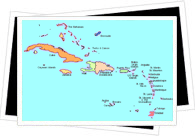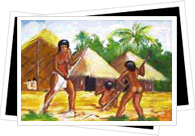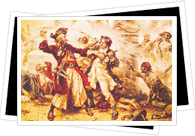
The Caribbean is the area of islands and mainland coasts in the Caribbean Sea. It comprises over 7000 islands including the West Indies and Antilles.
The islands and countries in the Caribbean include; the Bahamas, Barbados, Cuba, the Dominican Republic, Haiti, Jamaica, Martinique, Saint Lucia and Trinidad and Tobago.
Mainland countries with Caribbean coastlines or islands include Belize, Columbia, Costa Rica, Guatemala, Guyana, Honduras, Mexico, Nicaragua, Panama and Venezuela. Half of the total Caribbean land mass is flat and half is sloped.

7000 years ago the Caribbean was home to two tribes of Amerindians, the Taínos or Arawaks who inhabited the Bahamas and Greater Antilles area and the Caribs who travelled from Venezuela, in South America and settled in the Lesser Antilles.
The Taínos were a peaceful, gentle tribe known for trading crops and basket weaving. They would sleep in hammocks and enjoyed a varied diet of birds, fish, small animals, cassova, corn and fruits. In contrast, the culture of the Caribs was a people who would pillage villages to take slaves and steal supplies. They were known for their honed pottery skills and having a taste for human flesh. Pictographs of the Taíno can be seen in many of the caves situated within the Eastern National Park in the Dominican Republic.
When Columbus discovered the West Indies the Caribs had already started systematically eliminating the Taínos, island by island and so the Caribbean was named after the Caribs as the stronger native tribe. However, it was the arrival of the Europeans which ultimately led to the demise of the Taínos as the race was wiped out within the subsequent 50 years.

After fighting with the natives, confrontations broke out between the European countries controlling different islands as each country tried to take more. The Caribbean wars continued until the 1830's when reliance on the sugar production in the islands decreased.
Pirates famously rampaged the waters of the Caribbean for some 80 years, dying out in the 1720's as the European Navies combatted against their pillaging. They had a reputation for brutality and were known as the Buccaneers, living on the islands of Tortuga and Hispaniola (now Haiti and the Dominican Republic) and attacking ships as far away as the Indian Ocean. As the pirates were wiped out, slaves were brought from Africa and although the 1770's saw anti-slavery movements in Europe, it took another century for the Caribbean countries to stop importing African slaves.
Nowadays the Caribbean is associated with soft pale sands, turquoise seas and cocktails by the poolside whilst soaking up average temperatures of 30 degrees Celsius. Although a tropical area, each of the islands can boast different features; cool sea breezes, tropical rainforests, lagoons, desert-like landscapes filled with cactus, colonial architecture, water sports and more.
The Caribbean is truly a place where you can take your pick of activities or just soak up the melting point of different cultures and enjoy the fiesta with the locals.